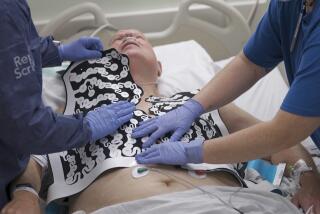Fewer treatments, more free time for breast cancer patients
- Share via
When Marie Desilets discovered a year or so ago that she needed radiation for breast cancer, she faced a dilemma.
The 82-year-old, who lives about an hour’s drive from Brigham and Women’s Hospital in Boston, could get regular radiation treatments, which would require her to be in Boston five days a week for seven weeks. Or she could opt for a new type of radiation that requires only 10 treatments -- given twice a day for five days.
In the standard method, the whole breast is irradiated; in the new one, radiation is aimed at only the tumor’s former location.
Desilets chose the latter, and went shopping every day between the first and second treatments.
“It was a piece of cake,” she said. “I highly recommend it. I felt great the whole time.”
More than half of women with relatively small tumors opt to skip a lumpectomy and instead have their entire breast removed -- usually to avoid radiation. Because radiation requires regular treatments for weeks and has side effects including skin irritation, it creates enormous difficulties for those who live far from medical centers or whose work schedules make it difficult to spend part of every day getting treatment.
But the new procedure, called accelerated partial breast radiation, could change the outcome of such decisions.
Although many insurers already pay for the procedure, it’s too soon to say whether the new technique is ready to replace the old, which is supported by decades of practice and studies. An estimated 71,000 women each year may be potential candidates for the treatment, which is available at many medical centers because of growing patient demand.
“The quandary is that the rationale for partial breast irradiation is compelling, but we are moving away from something that is tried and true with excellent long-term results to something that has at least something of a question mark,” said Dr. Jay Harris, chief of the department of radiation oncology at Brigham and Women’s Hospital and the Dana-Farber Cancer Institute.
On the other hand, the risk of the new approach is probably small.
When cancer returns to a breast, it almost always does so in the initial tumor site, not in a more distant part of the breast, said Dr. Phillip Devlin, director of brachytherapy at Brigham and Women’s Hospital and the Dana-Farber Cancer Institute. That suggests tightly targeted radiation should do the trick.
Although radiation is important for reducing the risk of recurrence of cancer in the same breast, it does not affect overall survival. Unlike chemotherapy, designed to knock out cancer cells anywhere in the body, “radiation controls local recurrence,” said Dr. Oscar Streeter, associate professor of clinical radiation oncology at the Keck School of Medicine at the University of Southern California.
Because of its newness, partial breast irradiation is generally recommended specifically for women with small tumors in only one section of the breast and no signs of cancer in the lymph nodes.
In one of three forms of the new procedure, called catheter-based or interstitial radiation, doctors numb the breast, then insert 10 to 20 small tubes in the area where the tumor was. They then insert a radioactive “seed” containing Iridium 192 into each catheter, leave it in briefly, then take the seed out and put it in the next catheter.
The procedure takes about 10 minutes, said Dr. Frank Vicini, chief of oncology at the William Beaumont Hospital in Royal Oak, Mich., and principal investigator of a new trial of partial breast irradiation in 3,000 women.
The radiation is given twice a day for five days -- the tubes stay in the whole time -- and provides the same tumor-killing effect as standard radiation, said Vicini, author of a study in 2003 of nearly 400 women, half of whom got the new radiation and the other half, whole-breast radiation. After five years, the study showed, there was no significant difference in the rate of local recurrence.
In the second approach, a device called the MammoSite is used to insert just one catheter into the cavity where the tumor was.
So far, women receiving MammoSite treatment have been followed for only about two years, but the data look promising.
The third, and newest, approach involves an old-style external beam and is called 3D conformal radiation, or a similar technique called IMRT, for intensity-modulated radiation therapy. Instead of targeting the radiation to the whole breast, the beam is aimed with exquisite precision, using CT scans, to just the area where the tumor was.
For Desilets, who had the MammoSite procedure, the new radiation was a breeze. “I didn’t feel anything. My skin didn’t get red. There were no repercussions at all.”




